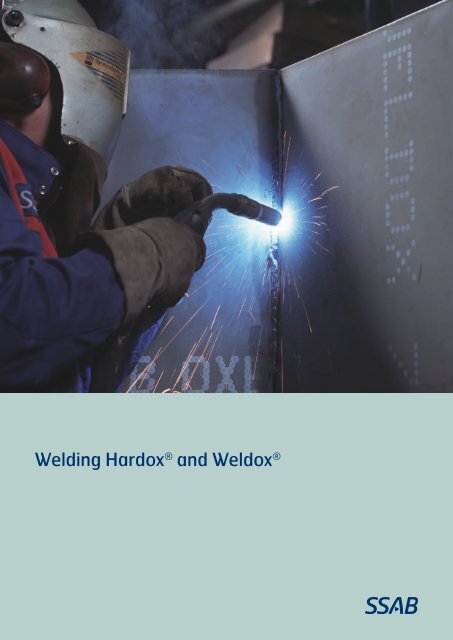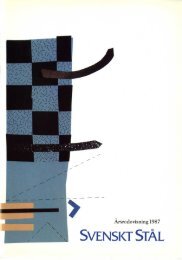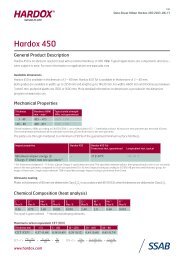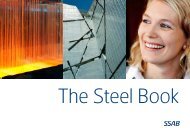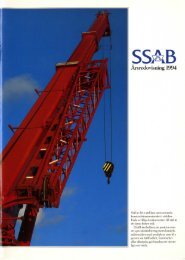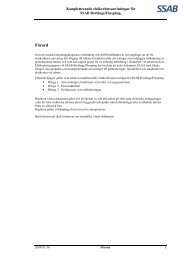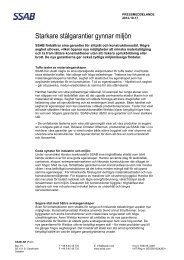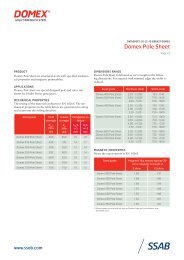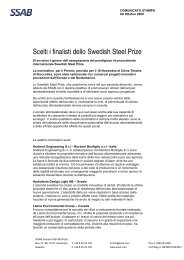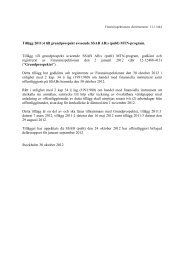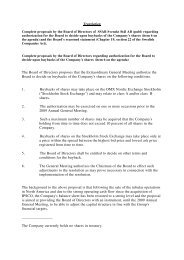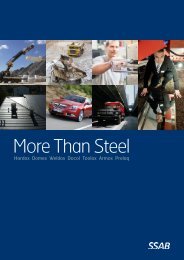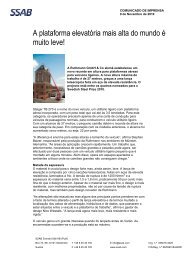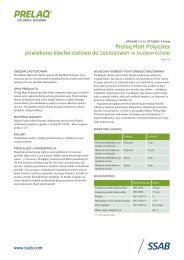Welding Hardox® and Weldox®
Welding Hardox® and Weldox®
Welding Hardox® and Weldox®
You also want an ePaper? Increase the reach of your titles
YUMPU automatically turns print PDFs into web optimized ePapers that Google loves.
<strong>Welding</strong> Hardox ® <strong>and</strong> Weldox ®
The contents of this brochure represent general suggestions. SSAB AB accepts no responsibility for their suitability in<br />
individual cases. The user is therefore responsible to make the necessary adaptations to the conditions in each individual case.
<strong>Welding</strong> of Weldox ® <strong>and</strong> Hardox ®<br />
The extreme performance of Weldox high strength steel <strong>and</strong> Hardox wear plate<br />
is combined with exceptional weldability. Any conventional welding<br />
method can be used for welding these steels to any type of weldable steel.<br />
This brochure is aimed at simplifying, improving <strong>and</strong> boosting the efficiency of<br />
the welding process. It offers good advice on preheat <strong>and</strong> interpass<br />
temperatures, heat input, welding consumables, shielding gas <strong>and</strong> a great deal<br />
more. The aim is to enable every user to gain full benefit of the unique<br />
properties of Weldox <strong>and</strong> Hardox.
Important parameters in welding<br />
Clean the joint to remove foreign matter such as moisture <strong>and</strong> oil residue before welding. In addition to<br />
good welding hygiene, the following items are important:<br />
Preheat <strong>and</strong> interpass temperature<br />
Heat input<br />
<strong>Welding</strong> consumables<br />
Preheat <strong>and</strong> interpass temperatures<br />
The right preheat <strong>and</strong> interpass temperature is important in order to avoid hydrogen cracking.<br />
Our recommendations are given in the table on the next page.<br />
Influence of AlloyIng elemenTs on THe cHoIce of PreHeAT And InTerPAss TemPerATures<br />
A unique combination of alloying elements optimizes<br />
the mechanical properties of Weldox <strong>and</strong> Hardox. This<br />
combination governs the preheat <strong>and</strong> interpass temperature<br />
of the steel during welding, <strong>and</strong> can be used<br />
to calculate the carbon equivalent value. The carbon<br />
equivalent value is usually expressed as CEV or CET in<br />
accordance with the equations below.<br />
mn (mo+cr+V) (ni+cu)<br />
ceV = c + + + [%]<br />
6 5 15<br />
Hydrogen crAckIng<br />
The alloying elements are specified in the inspection certificate<br />
of the plate <strong>and</strong> are stated in percent by weight<br />
in these formulas. A higher carbon equivalent usually<br />
requires a higher preheat <strong>and</strong> interpass temperature.<br />
Typical values of carbon equivalents are given in our<br />
product data sheets.<br />
(mn+mo) (cr+cu) ni<br />
ceT = c + + + [%]<br />
10 20 40<br />
Due to their low carbon equivalents, Weldox <strong>and</strong> Hardox are better able to resist hydrogen cracking than many<br />
other high strength steels. The risk of hydrogen cracking will be minimized if our recommendations are followed.<br />
Two rules for avoiding hydrogen cracking:<br />
1. mInImIze THe Hydrogen conTenT In And Around<br />
THe PrePAred joInT<br />
Use the right preheat <strong>and</strong> interpass<br />
temperature<br />
Use welding consumables with a low<br />
hydrogen content<br />
Keep impurities out of the weld area<br />
Shielding gas<br />
Weld sequence <strong>and</strong> gap size in the joint<br />
2. mInImIze THe sTresses In THe Weld joInT<br />
Do not use welding consumables of a higher<br />
strength than is necessary<br />
Arrange the weld sequence so that the<br />
residual stresses are minimized<br />
Set the gap in the joint to a maximum of 3 mm
PreHeAT And InTerPAss TemPerATures for Weldox And HArdox<br />
The lowest preheat <strong>and</strong> interpass temperature during welding is shown in the chart below. Unless otherwise stated,<br />
these values are applicable for welding with unalloyed <strong>and</strong> low-alloyed welding consumables.<br />
When plates of different thicknesses, but of the same steel grade are welded together, the thickest plate<br />
determines the required preheat <strong>and</strong> interpass temperature.<br />
When different steel types are welded together, the plate requiring the highest preheat temperature<br />
determines the required preheat <strong>and</strong> interpass temperature.<br />
MINIMUM RECOMMENDED PREHEAT AND INTERPASS TEMPERATURES FOR DIFFERENT SINGLE PLATE THICKNESSES [mm]<br />
Weldox 700<br />
Weldox 900*<br />
Weldox 960*<br />
Weldox 1030*<br />
Weldox 1100*<br />
Weldox 1300*<br />
Hardox HiTuf<br />
Hardox 400<br />
Hardox 450<br />
Hardox 500<br />
Hardox 550<br />
75°C<br />
100°C<br />
125°C<br />
Hardox 600 150°C<br />
Hardox 600<br />
Stainless steel consumables<br />
Hardox Extreme<br />
Stainless steel consumables<br />
3 10 20 30 40 50 60 70 80 90 120 130<br />
75°C<br />
175°C<br />
175°C<br />
175°C<br />
125°C<br />
125°C<br />
100°C<br />
100°C<br />
100°C<br />
75°C<br />
75°C<br />
200°C<br />
100°C<br />
100°C<br />
100°C<br />
200°C<br />
150°C<br />
175°C<br />
100°C<br />
Room temperature (approx. 20°C) Outside the size range Only stainless steel consumables<br />
Note: The table is applicable to single plate thickness when welding with a heat input of 1.7 kJ / mm.<br />
Further information on single plate thickness can be found in TechSupport #61 at www.ssab.com.<br />
mAxImum recommended InTerPAss TemPerATure<br />
Weldox 700** 300°C<br />
Weldox 900** 300°C<br />
Weldox 960** 300°C<br />
Weldox 1030 200°C<br />
Weldox 1100 200°C<br />
Weldox 1300 200°C<br />
Hardox HiTuf** 300°C<br />
Hardox 400 225°C<br />
Hardox 450 225°C<br />
Hardox 500 225°C<br />
Hardox 550 225°C<br />
Hardox 600 225°C<br />
Hardox Extreme 100°C<br />
* The consumables determine the preheating temperature if its carbon equivalent is higher than that of the plate.<br />
** Interpass temperatures of up to approx. 400 °C can be used in certain cases for Weldox 700–960 <strong>and</strong> for Hardox HiTuf. In such cases, use WeldCalc.<br />
125°C<br />
200°C<br />
t 1 = t 2 (dimensions in mm)<br />
The single plate thickness in the<br />
table is t 1 or t 2 , provided that the<br />
same steel type is used.<br />
t 1 = t 2 (dimensions in mm)<br />
The single plate thickness in the<br />
table is t 1 or t 2 , provided that the<br />
same steel type is used.<br />
t 1 < t 2 (dimensions in mm)<br />
In this case, the single plate thickness<br />
in the table is t 2 ,<br />
provided that the same steel type<br />
is used.
If the ambient humidity is high or the temperature is<br />
below +5 °C, the lowest recommended preheat temperatures<br />
given on the previous page should be increased by<br />
25 °C. This also applies to firmly clamped weld joints<br />
<strong>and</strong> if the heat input is 1.0 kJ / mm.<br />
The lowest recommended preheat <strong>and</strong> interpass<br />
temperatures in the chart on the previous page are not<br />
ATTAInIng And meAsurIng THe PreHeAT And InTerPAss TemPerATure<br />
The required preheat <strong>and</strong> interpass temperature can be<br />
achieved in several ways. Electric preheater elements<br />
around the prepared joint are often best, since they<br />
Using preheater elements<br />
affected at heat inputs higher than 1.7 kJ / mm.<br />
The information is based on the assumption that the<br />
welded joint is allowed to cool in air.<br />
Note that these recommendations also apply to tack<br />
welds <strong>and</strong> root runs. Each of the tack welds should be at<br />
least 50 mm long. The distance between tack welds can<br />
be varied as required.<br />
provide uniform heating of the area. The temperature<br />
should be monitored by using, for example, a contact<br />
thermometer.<br />
Measure the preheat<br />
temperature here<br />
75 mm<br />
Intended<br />
weld joint<br />
Measure the temperature of the thickest plate in the joint. If the plate is 25 mm<br />
thick, measure the temperature 2 minutes after heating. If the plate is 12.5 mm<br />
thick, measure the temperature after 1 minute, etc. The interpass temperature<br />
can be measured in the weld metal or in the immediately adjacent parent metal.
Heat input<br />
WeldIng WITH THe recommended HeAT InPuT resulTs In good mecHAnIcAl ProPerTIes In<br />
THe HeAT AffecTed zone (HAz)<br />
The heat supplied by the welding process affects the<br />
mechanical properties of the welded joint. This is<br />
described by the heat input (Q) that can be calculated<br />
using the formula below.<br />
Q =<br />
k x u x I x 60<br />
v x 1000<br />
Q = Heat input [kj/mm]<br />
u = Voltage [V]<br />
I = current [A]<br />
v = <strong>Welding</strong> speed [mm/min]<br />
k = Thermal efficiency [dimensionless]<br />
effecTs of HeAT InPuT on A Weld joInT<br />
Better toughness<br />
Increased strength<br />
Reduced deformation<br />
Lower residual stresses<br />
Narrower HAZ<br />
Different methods of welding have varying thermal<br />
efficiency (k). See the table below for approximate<br />
values of this property.<br />
Thermal efficiency k [dimensionless]<br />
mmA 0.8<br />
mAg, all types 0.8<br />
sAW 1.0<br />
TIg 0.6<br />
reduced heat input Increased heat input<br />
Higher productivity for<br />
conventional welding<br />
methods
Our recommendations for Weldox high strength steel are based on typical values for toughness in the HAZ being<br />
at least 27 J at -40 °C. The dem<strong>and</strong>s on toughness in the weld joints in Hardox wear plate are often lower.<br />
The recommendations for Hardox should therefore be regarded as approximate values.<br />
When a joint comprising different plate thicknesses is welded, the recommended<br />
heat input is based on the thinnest plate in the welded joint.<br />
Heat input [kJ/mm]<br />
Heat input [kJ/mm]<br />
4,0<br />
3,5<br />
3,0<br />
2,5<br />
2,0<br />
1,5<br />
1,0<br />
0,5<br />
0,0<br />
4.0<br />
3.5<br />
3.0<br />
2.5<br />
2.0<br />
1.5<br />
1.0<br />
0.5<br />
0.0<br />
RECOMMENDED MAXIMUM HEAT INPUT FOR WELDOX, BASED ON THE LOWEST PREHEAT TEMPERATURE BEING USED:<br />
0<br />
5 10 15 20 25 30 35 40 –130<br />
RECOMMENDED MAXIMUM HEAT INPUT FOR HARDOX<br />
Plate thickness [mm]<br />
0 5 10 15 20 25 30 35 40-130<br />
Plate thickness [mm]<br />
11 mm<br />
Qmax Weldox 700<br />
Qmax Weldox 900<br />
Qmax Weldox 960<br />
Qmax Weldox 1030<br />
Qmax Weldox 1100<br />
Qmax Weldox 1300<br />
Hardox<br />
20 mm<br />
In this case, the permissible heat input is based<br />
on the 11 mm plate thickness.
WeldIng AT HIgHer eleVATed TemPerATures<br />
Higher elevated temperatures that may occur, for instance in multipass weld joints, affect the recommended heat<br />
input. The figure below shows the recommended heat inputs for joint temperatures of 125 °C <strong>and</strong> 175 °C.<br />
Heat input [kJ/mm]<br />
Heat input [kJ/mm]<br />
4,0<br />
3,5<br />
3,0<br />
2,5<br />
2,0<br />
1,5<br />
1,0<br />
0,5<br />
0,0<br />
4,0<br />
3,5<br />
3,0<br />
2,5<br />
2,0<br />
1,5<br />
1,0<br />
0,5<br />
0,0<br />
0<br />
0<br />
RECOMMENDED MAXIMUM HEAT INPUT FOR THE JOINT TEMPERATURE OF 125ºC<br />
5 10 15 20 25 30 35 40–130<br />
Plate thickness [mm]<br />
RECOMMENDED MAXIMUM HEAT INPUT FOR THE JOINT TEMPERATURE OF 175ºC<br />
5 10 15 20 25 30 35 40–130<br />
Plate thickness [mm]<br />
The WeldCalc computer program can be used for preheat <strong>and</strong> interpass temperatures above 175 °C.<br />
WeldCalc has been developed by SSAB by our world leading experts on the welding of heavy plate.<br />
The program can be ordered free of charge at www.ssab.com.<br />
Qmax Weldox 700<br />
Qmax Weldox 900<br />
Qmax Weldox 960–1300<br />
Qmax Weldox 700<br />
Qmax Weldox 900<br />
Qmax Weldox 960–1300
<strong>Welding</strong> consumables<br />
Unalloyed, low-alloyed <strong>and</strong> stainless steel consumables can be used for the welding of Weldox <strong>and</strong> Hardox.<br />
sTrengTHs of unAlloyed And loW-Alloyed WeldIng consumAbles<br />
The strength of the welding consumables should be<br />
selected in accordance with the figure on the next page.<br />
Using low-strength consumables can offer several benefits,<br />
such as higher toughness of the weld metal, higher<br />
resistance to hydrogen cracking <strong>and</strong> lower residual<br />
stresses in the weld joint. In multipass joints in Weldox<br />
700–1300, it is particularly beneficial to weld with consumables<br />
of different strengths. Tack welds <strong>and</strong> the first<br />
passes are welded with low strength consumables <strong>and</strong><br />
then high strength consumables are used for the remainder<br />
of the passes. This technique can increase both the<br />
<strong>Welding</strong> consumables with higher strength<br />
The hydrogen content should be lower than or equal<br />
to 5 ml of hydrogen per 100 g of weld metal when<br />
welding with unalloyed or low-alloyed welding consumables.<br />
Solid wires used in MAG <strong>and</strong> TIG welding<br />
can produce these low hydrogen contents in the weld<br />
metal. The hydrogen content for other types of welding<br />
consumables can best be obtained from the respective<br />
manufacturer.<br />
toughness <strong>and</strong> the resistance to hydrogen cracking.<br />
The carbon equivalent value of consumables with a<br />
yield strength > 700 MPa may be higher than that of the<br />
plates.<br />
When there are different recommended preheat temperatures<br />
for the joint materials <strong>and</strong> the consumables,<br />
then the highest value should be used. Hardox should<br />
be welded with low strength consumables as shown in<br />
the figure on the following page.<br />
<strong>Welding</strong> consumables with higher strength<br />
<strong>Welding</strong> consumables with lower strength<br />
Hydrogen <strong>Welding</strong> consumables conTenT with lower of strength unAlloyed And loW-Alloyed WeldIng consumAbles<br />
Examples of consumables are given at www.ssab.<br />
com in the publication TechSupport #60. If consumables<br />
are stored in accordance with the manufacturer’s<br />
recommendations, the hydrogen content will be maintained<br />
at the intended level. This applies, above all, to<br />
coated consumables <strong>and</strong> fluxes.
Recommended<br />
strength of<br />
consumables for<br />
highly stressed joints<br />
Recommended strength of<br />
consumables for other<br />
joints<br />
Hardox HiTuf<br />
Hardox 400<br />
Hardox 450<br />
Hardox 500<br />
Hardox 550<br />
Hardox 600<br />
Recommended<br />
strength of<br />
consumables for<br />
highly stressed joints<br />
Recommended strength of<br />
consumables for other<br />
joints<br />
Hardox HiTuf<br />
Hardox 400<br />
Hardox 450<br />
Hardox 500<br />
Hardox 550<br />
Hardox 600<br />
Weldox700<br />
Weldox700<br />
Weldox 900<br />
Weldox 900<br />
Weldox 960<br />
Weldox 960<br />
Weldox 1030<br />
Weldox 1030<br />
Weldox 1100<br />
Weldox 1100<br />
R [MPa]<br />
p0.2<br />
Weldox 1300<br />
900<br />
800<br />
700<br />
600<br />
500<br />
400<br />
R [MPa]<br />
p0.2<br />
Weldox 1300<br />
900<br />
800<br />
700<br />
500<br />
400<br />
<strong>Welding</strong> consumables, EN class<br />
MMA SAW MAG MAG<br />
EN 757 E 89 X<br />
EN 757 E 79 X<br />
EN 757 E 69 X<br />
EN 757 E 62 X<br />
EN 757 E 55 X<br />
EN ISO 2560 E 50 X<br />
EN ISO 2560 (-A)E 46 X<br />
EN ISO 2560 (-A) E 42 X<br />
(solid wire/flux<br />
combinations)<br />
Note that X may st<strong>and</strong> for one or several characters.<br />
AWS A5.5 E120X<br />
AWS A5.5 E110X<br />
AWS A5.5 E100X<br />
AWS A5.5 E90X<br />
AWS A5.5 E80X<br />
AWS A5.5 E70X<br />
<strong>Welding</strong> consumables, AWS class<br />
Note that X st<strong>and</strong>s for one or several characters.<br />
(solid wire)<br />
EN ISO 26304 (-A) S 89X EN ISO 16834 (-A) G 89X EN ISO 18276 (-A) T 89X EN ISO 16834 (-A) W 89X<br />
EN ISO 26304 (-A) S 79X<br />
EN ISO 26304 (-A) S 69X<br />
EN ISO 26304 (-A) S 62X<br />
EN ISO 26304 (-A) S 55X<br />
EN 756<br />
EN 756<br />
EN 756<br />
AWS A5.23 F12X AWS A5.28 ER120S-X AWS A5.29 E12XT-X AWS A5.28 E120C-X AWS A5.28 ER120X<br />
AWS A5.23 F11X<br />
AWS A5.23 F10X<br />
AWS A5.23 F9X<br />
AWS A5.23 F8X<br />
AWS A5.23 F7X<br />
S 50X<br />
S 46X<br />
S 42X<br />
EN ISO 16834 (-A) G 79X<br />
EN ISO 16834 (-A) G 69X<br />
EN ISO 16834 (-A) G 62X<br />
EN ISO 16834 (-A) G 55X<br />
EN ISO 14341 (-A) G 50X<br />
EN ISO 14341 (-A) G 46X<br />
EN ISO 14341 (-A) G 42X<br />
MMA SAW MAG MAG<br />
(solid wire/flux<br />
combinations)<br />
(solid wire)<br />
AWS A5.28 ER100S-X<br />
AWS A5.28 ER110S-X<br />
AWS A5.28 ER90S-X<br />
AWS A5.28 ER80S-X<br />
AWS A5.28 ER70S-X<br />
(flux cored<br />
wire)<br />
AWS A5.29 E11XT-X<br />
AWS A5.29 E10XT-X<br />
AWS A5.29 E9XT-X<br />
AWS A5.29 E8XT-X<br />
AWS A5.29 E7XT-X<br />
(all types of tubular<br />
cored wires)<br />
EN ISO 18276 (-A) T 79X<br />
EN ISO 18276 (-A) T 69X<br />
EN ISO 18276 (-A) T 55X<br />
EN ISO 16834 (-A) T 50X<br />
EN ISO 16834 (-A) T 46X<br />
EN ISO 16834 (-A) T 42X<br />
MAG<br />
(metal cored<br />
wire)<br />
AWS A5.28 E110C-X<br />
AWS A5.28 E100C-X<br />
AWS A5.28 E90C-X<br />
AWS A5.28 E80C-X<br />
AWS A5.28 E70C-X<br />
TIG<br />
EN ISO 16834 (-A) W 79X<br />
EN ISO 16834 (-A) W 69X<br />
EN ISO 16834 (-A) W 62X<br />
EN ISO 16834 (-A) W 55X<br />
EN ISO 636 (-A)<br />
EN ISO 636 (-A)<br />
EN ISO 636 (-A)<br />
W 50X<br />
W 46X<br />
W 42X<br />
TIG<br />
AWS A5.28 ER110X<br />
AWS A5.28 ER100X<br />
AWS A5.28 ER90X<br />
AWS A5.28 ER80X<br />
AWS A5.28 ER70X
sTAInless sTeel WeldIng consumAbles<br />
Consumables of austenitic stainless steels can be used<br />
for the welding of all our products. They allow welding<br />
at room temperature (+20 °C) without preheating,<br />
excluding Hardox 600, as shown in the chart.<br />
We recommend giving first preference to consumables<br />
in accordance with AWS 307 <strong>and</strong> second preference<br />
to those in accordance with AWS 309. These types of<br />
consumables have yield streghts up to approximately<br />
500 MPa in all the weld metal. The AWS 307 type can<br />
All Weldox <strong>and</strong><br />
Hardox steels<br />
All Weldox <strong>and</strong><br />
Hardox steels<br />
500<br />
500<br />
Hard facings<br />
Stainless steel welding consumables, EN class<br />
MMA<br />
First preference:<br />
EN 1600: E 18 8 Mn<br />
Second preference:<br />
EN 1600: E 19 12 X<br />
SAW<br />
(solid wire)<br />
First preference:<br />
EN ISO 14343-A: B 18 8 Mn/<br />
EN ISO 14343-B: SS307<br />
Second preference:<br />
EN ISO 14343-A: S 23 12 X/<br />
EN ISO 14343-B: SS309X<br />
Note that X may st<strong>and</strong> for one or several characters.<br />
Stainless steel welding consumables, AWS class<br />
Note that X st<strong>and</strong>s for one or several characters.<br />
withst<strong>and</strong> hot cracking better than AWS 309. It should<br />
be noted that manufacturers seldom specify the<br />
hydrogen content of stainless steel consumables, since<br />
hydrogen does not affect the performance as much as it<br />
does in unalloyed <strong>and</strong> low-alloyed consumables. Suggestions<br />
for various stainless steel consumables are given at<br />
www.ssab.com in the publication TechSupport #60.<br />
MAG<br />
(solid wire)<br />
First preference:<br />
EN ISO 14343-A: B 18 8 Mn/<br />
EN ISO 14343-B: SS307<br />
Second preference:<br />
EN ISO 14343-A: B 23 12 X/<br />
EN ISO 14343-B: SS309X<br />
MMA SAW MAG<br />
MAG<br />
(solid wire) (solid wire)<br />
(flux cored wire)<br />
Hardfacing<br />
Steel substrate<br />
MAG<br />
(all types of<br />
cored wires)<br />
First preference:<br />
EN ISO 17633-A: T 18 8 Mn/<br />
EN ISO 17633-B: TS307<br />
Second preference:<br />
EN ISO 17633-A: T 23 12 X/<br />
EN ISO 17633-B: TS309X<br />
(metal cored wire)<br />
TIG<br />
First preference:<br />
EN ISO 14343-A: W 18 8 Mn/<br />
EN ISO 14343-B: SS307<br />
Second preference:<br />
EN ISO 14343-A: W 23 12 X/<br />
EN ISO 14343-B: SS309X<br />
MAG TIG<br />
AWS 5.4 E307-X AWS 5.9 ER307 AWS 5.9 ER307 AWS 5.22 E307T-X AWS 5.9 EC307 AWS 5.9 ER307<br />
Hard facing with special consumables increases the<br />
wear resistance of welded joints. Both the instructions<br />
for the consumables used <strong>and</strong> the ordinary recommendations<br />
for Weldox <strong>and</strong> Hardox should be followed.<br />
It is beneficial to weld a buffer layer with extra high<br />
toughness between the ordinary welded joint or plate<br />
<strong>and</strong> the hard facing. The choice of consumables for the<br />
buffer layer should follow the welding recommendations<br />
forWeldox <strong>and</strong> Hardox steels. Stainless steel<br />
consumables in accordance with AWS 307 <strong>and</strong> AWS<br />
309 should preferably be used for the buffer layer.<br />
Buffer layer
shielding gas<br />
The choice <strong>and</strong> mixture of shielding gases is dependent on the welding situation <strong>and</strong> Ar <strong>and</strong> CO 2 are<br />
the most commonly used.<br />
effecTs of VArIous sHIeldIng gAs mIxTures<br />
Facilitates striking of<br />
the arc<br />
Reduced spatter<br />
Low amount of oxides<br />
exAmPles of sHIeldIng gAs mIxTures Are gIVen beloW.<br />
In all welding methods based on shielding gas, the flow of shielding gas is dependent on the welding situation.<br />
A general guideline is that the shielding gas flow in l / min should be set to the same value as the inside diameter of<br />
the nozzle measured in mm.<br />
Weld sequences <strong>and</strong> gap size<br />
To AVoId Hydrogen crAcks In THe Welded<br />
joInT:<br />
The starting <strong>and</strong> stopping sequences should not be<br />
located in a corner. If possible, the starting <strong>and</strong><br />
stopping procedures should be at least 5–10 cm<br />
from a corner.<br />
The gap in the weld joint should be a maximum<br />
of 3 mm.<br />
Ar (inert gas) Ar/CO 2 (active gas) CO 2<br />
<strong>Welding</strong> method Arc type shielding gas (volume %)<br />
MAG, solid wire<br />
MAG, metal cored wire<br />
MAG, solid wire<br />
MAG, metal cored wire<br />
Short arc<br />
Spray arc<br />
Ar + 15-25 % CO 2<br />
Ar + 8-25 % CO 2<br />
MAG, flux cored wire Short arc Ar + 15-25 % CO 2 , or pure CO 2<br />
MAG, flux cored wire Spray arc Ar + 8-25 % CO 2<br />
MAG, all types All arc types Ar + 15-25 CO2 TIG Pure Ar<br />
Max. gap of 3 mm<br />
Stable arc<br />
Low porosity<br />
More weld spatter/clogging<br />
of the welding nozzle<br />
High penetration of the<br />
weld metal<br />
Max. gap of 3 mm
<strong>Welding</strong> on the Weldox <strong>and</strong> Hardox primer<br />
For best possible results, the primer can be removed.<br />
Post weld heat treatment<br />
<strong>Welding</strong> can be carried out directly on the excellent<br />
Weldox <strong>and</strong> Hardox primer, due to its low zinc content.<br />
The primer can easily be brushed or ground away in<br />
the area around the joint. Removing the primer prior<br />
to welding can be beneficial, as it can minimize the<br />
porosity in the weld <strong>and</strong> can facilitate welding in<br />
positions other than the horizontal.<br />
If the primer is left on the weld preparation, the<br />
porosity of the weld metal will be slightly increased.<br />
The MAG welding process with flux cored wire <strong>and</strong> the<br />
MMA welding process offer the lowest porosity.<br />
As in all welding operations good ventilation must<br />
be maintained, then the primer will not have a harmful<br />
effect on the welder <strong>and</strong> his surroundings.<br />
For further information, download TechSupport #25<br />
from www.ssab.com.<br />
Hardox HiTuf <strong>and</strong> Weldox 700–960 can be stress relieved by post weld heat treatment, although this is<br />
seldom necessary. Other Weldox <strong>and</strong> Hardox steels should not use this method for stress relieving, since<br />
this may impair the mechanical properties.<br />
For further information, see the <strong>Welding</strong> H<strong>and</strong>book from SSAB. This can be ordered at www.ssab.com.
SSAB is a global leader in value added, high strength steel. SSAB offers products<br />
developed in close cooperation with its customers to reach a stronger, lighter <strong>and</strong><br />
more sustainable world.<br />
SSAB employs over 8 700 people in over 45 countries around the world <strong>and</strong> operates<br />
production facilities in Sweden <strong>and</strong> the US. SSAB is listed on the NASDAQ OMX<br />
Nordic Exchange, Stockholm.<br />
For more information, contact us or visit www.ssab.com<br />
ssAb<br />
SE-613 80 Oxelösund<br />
Sweden<br />
T +46 155 25 40 00<br />
F +46 155 25 40 73<br />
E contact@ssab.com<br />
www.ssab.com<br />
011-<strong>Welding</strong>-UK-v3-2010. Österbergs & Sörml<strong>and</strong>stryck, Nyköping.


